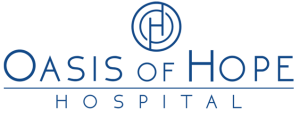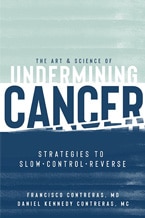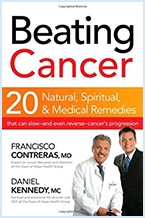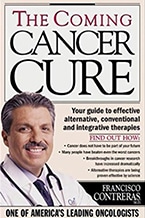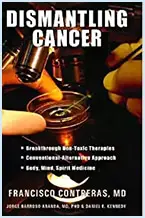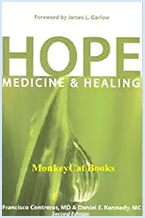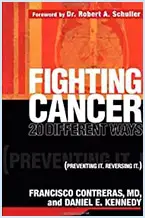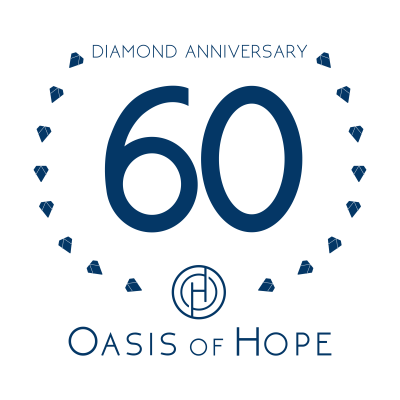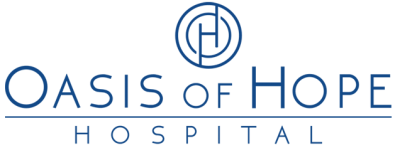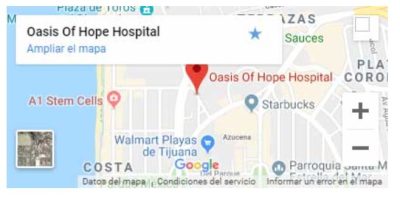Nutraceuticals For Cancer Control
The Place for Alternative Cancer
The behaviors of healthy and malignant cells depend on many factors, including nutrients, DNA, vascularization, hormones and cell signaling. Malignant cells are mutated cells that multiply abnormally and do not die. At the core of their abnormal behavior are cell signals. Specific nutrients have been found to affect cell signaling in ways that can cut off malignant cells from the elements they need to proliferate. In the same way, these nutrients can induce cell death (apoptosis) and make the cancer vulnerable to treatment. Specific nutrients also activate the immune response to cancer. Our doctors will prescribe many nutraceuticals that include anti-cancer/pro-immune system elements such as Vitamin D3, melatonin, selenium, green tea extract, AHCC and Nano Vitamin C. Though some of these nutrients are available at vitamin shops, the nutraceuticals we prescribe have been prepared at our laboratory at a pharmaceutical grade, with the exact dose and purity needed to achieve the desired therapeutic effect, for continuing use when patients return home.
AHCC
A good method on how the Oasis of Hope bolsters the immune system is using active hexose correlated compound (AHCC), an extract obtained from several kinds of mushroom. Mushroom extracts are known to have immunomodulation and antitumor effects. AHCC is very effective in strengthening and optimizing the capacity of the immune system.
The Oasis of Hope clinical research organization conducted a study comparing patients taking chemotherapy combined with AHCC and another group taking chemotherapy alone. One of the nasty side effects of chemotherapy is that it can severely depress the immune system.
We found that AHCC truly protected the immune system from the depressing effects of chemotherapy.
AHCC can reduce the side effects of radiotherapy as well. AHCC also improves patients’ quality of life by reducing nausea, increasing appetite, and decreasing anxiety. Furthermore, there are no side effects to taking AHCC as an immune -enhancing supplement.
Like melatonin, AHCC also stimulates the immune surveillance system. Cancer cells release several kinds of immune suppressive factors which inhibit the body’s ability to combat the disease. When the immune system is suppressed, something of a “chain reaction” occurs that results in the inhibition of the antitumor effects, which should come naturally to the body. The anticancer immune response fails when the production of killer cells fails. Thus, restoring the suppressed immune system is a very important part of cancer treatment, as is reversing any damage to it.
AHCC restores a depressed immune system and reverses damage by inhibiting the immune-suppressive factors produced by the cancer cells, increasing production of the cells that attack cancer, and stimulating the activity of the killer cells. For this reason, AHCC is an important part of the well-rounded Oasis of Hope treatment program.
Caffeine
Adenosine is another immunosuppressive agent produced in many tumors, especially in poorly oxygenated tumor regions. Yet, for a long time, doctors have known that the energizing effects of caffeine are evidence of caffeine’s ability to block the activation of adenosine receptors in the brain. Evidently, caffeine has the same potential in tumors, offsetting the immunosuppressive activity of tumor-produced adenosine. That is why, for patients who tolerate coffee easily, we recommend several cups daily.
Cimetidine
The anti-ulcer drug cimetidine is another immuno-supportive agent included in CMIT protocols primarily because of firm evidence that shows it can reduce the risk of metastasis in many cancers. However, there is also evidence that cimetidine has immuno-stimulant activity for natural killer cells and cytotoxic T-cells. These agents compromise one piece of the Oasis of Hope immune stimulation therapies.
Coenzyme Q10
Another powerful agent is CoQ10 or coenzyme Q10. This is a naturally occurring, fat-soluble substance that possesses vitamin-like properties. It is an essential component of the energy production process within our cells. However, while it is true that Q10 occurs naturally within the body, the levels decline as we age. If a person has high cholesterol, heart disease, or an addiction to cigarettes, these decreases can be significant. There is also clinical evidence linking cancer and immune system dysfunction to lowered levels of CoQ10.
What does this substance do that is so important? It acts as an amazingly effect antioxidant by scavenging free radicals. This means that CoQ10 defends against the onset of cancer and destroys existing cancer. One study tracked patients with a variety of cancers. This study showed that 60 percent became cancer free during therapy with CoQ10.
Another report noted partial remission of breast cancer in over 10 percent of the “high-risk” patients studied. These patients were treated with CoQ10. The same study also reported that the metastases of the primary tumor and the end of metastases in these cases are understood to be the result of the stimulating activity of coenzyme Q10 on the immune system.
Doctors would be foolish not to equip their patients with this powerful, disease-fighting weapon.
Diclofenac
With respect to Cox-2, there are many drugs, commonly referred to as NSAIDS, which can inhibit this enzyme. Some of these drugs are relatively selective to Cox-2 – including the prominently advertised drugs Vioxx and Celebrex. In other words, these drugs have little impact on the other form of cyclooxygenase (Cox-1). Prolonged effective inhibition of Cox-1 can lead to serious complications such as bleeding stomach ulcerations and kidney damage. For that reason, pharmaceutical companies developed Cox-2-specific inhibitors for use in the treatment of inflammatory disorders.
Instead of using the expensive, highly advertised and relatively new Cox-2-specific inhibitors, Celebrex or Vioxx, we at Oasis of Hope have decided to use a much older drug, diclofenac. Diclofenac has an activity spectrum nearly identical to that of Celebrex, producing effective inhibition of Cox-2 in concentrations that only modestly impact Cox-1, but it is much less expensive.89 While diclofenac has recently been shown to increase heart attack risk like other Cox-2 specific inhibitors do,90 we always use it in conjunction with low-dose aspirin, which likely will largely offset that risk.
Fish Oil / Omega 3
Fish oil is a uniquely rich source of the long-chain omega-3 fatty acids EPA (eicosapnetaenoic acid) and DHA (docosahexaenoic acid). A small structural difference distinguishes these fatty acids from the omega-6 fatty acids found in plant derived oils.
EPA and DHA have a valuable role to play in cancer treatment. Many studies show that a diet rich in fish oil tends to slow tumor growth. At least part of this effect can be attributed to a suppressive effect of fish oil on angiogenesis. Remember, angiogenesis is the process by which new blood vessels develop to enable the growth and spread of tumors.
EPA has been shown to decrease the expression of a key receptor in endothelial cells that makes them responsive to VEGF.
Another key factor in angiogenesis is the enzyme Cox-2.
In endothelial cells, it produces proteinoids required for vascular tube formation during the angiogenic process.42 A high intake of fish oil has the potential to antagonize the role of Cox-2 in the angiogenic process by decreasing the production of Cox-2-derived proteinoids in cancer cells.
Fish oil can fend off cachexia, the severe loss of muscle mass that often complicates late-stage cancer.
Although cachexia usually entails a loss of appetite that can contribute to weight loss by decreasing calorie intake, the life threatening selective loss of muscle mass often seen in cancer patients reflects a very specific inflammatory process in muscle fibers that is not seen in healthy dieters. It has been discovered that EPA interferes with the inflammatory mechanisms that cause loss of muscle mass.
Green Tea Extract
Boswellic acids are a group of closely related compounds found in salai guggul, a resinous extract from the tree Boswellia carteri that is traditionally used in Ayurvedic (Indian) medicine as an anti-inflammatory agent. In the early 1990s, German researchers discovered the mechanistic basis for salai guggul’s anti-inflammatory efficacy. Boswellic acids are very potent inhibitors of the enzyme 5-LPO-and thus can suppress production of leukotrienes which act as cancer growth factors.
The impact of 5-LPO activity on the sensitivity of cancers to chemotherapy or radiotherapy has received little attention up to this point. However, one fascinating recent report indicates that concurrent expression of 5-LPO is associated with substantial protection from the cytotoxicity of chemotherapeutic cancer drugs. Conversely, suppression of 5-LPO in these cancers greatly enhances their sensitivity to these drugs. This implies that 5-LPO inhibitors, administered prior to and during chemotherapy, should enhance the responsiveness of a high proportion of human cancers.
Zileuton is a drug that can inhibit 5-LPO and has shown cancer-retardant activity in hamsters with pancreatic cancer.69 However, we have chosen to use boswellic acid-rich extracts in Oasis of Hope CMIT regimensbecause they are considerably less expensive and can be presumed to be safe based on centuries of use in traditional medicine. Moreover, a number of cell culture studies indicate that boswellic acids, most notably one known as acetyl-l l-keto-beta-boswellic acid, can slow the proliferation and boost the death rate of various human cancer cell lines. The only published clinical experience with boswellic acids in the treatment of cancer dealt with the use of these agents in children with progressing brain cancers.75,76 Although some of the children experienced improved neurological function during this treatment, this might have reflected an anti-inflammatory effect of the observed benefit was worthwile. In rats transplanted with gliomas, treatment with boswellic acids could more than doule survival time. In the CMIT protocol and at-home regimen, we include a potent dose of boswellic acids.
Melatonin
One of the most intriguing immuno-supportive agents employed by Oasis of Hope is the hormone melatonin, administered once daily before bedtime. Multiple clinical studies in Italy show that this substance tends to have a very favorable, statistically significant impact on survival in patients with advanced cancer.
There is reason to believe that the chief reason for melatonin’s positive effect on survival in cancer patients is an immuno-stimulant effect that boosts the activity of natural killer cells and cytotoxic T-cells. This effect is indirect because melatonin acts on dendritic cells (specialized cells that function as antigen-presenting cells for T-cells), amplifying their capacity to stimulate natural killer cells and cytotoxic T-cells. Melatonin boosts the ability of dendritic cells to produce interleukin-2, which helps cancer-attacking immune cells reach maturity.
Pancreatic Enzymes
There is a key difference between normal cells and tumor cells. Normal cells are programmed to grow rapidly in their juvenile state, but their programming changes as they mature, eventually dictating some function for the cells to serve within the body.
Tumor cells never mature. Their programming freezes in the juvenile state, and they continue to reproduce at an alarming rate, sending trophoblasts through the body’s circulatory system to spread to other areas. So how do pancreatic enzymes address this problem?
Enzymes are essential biochemical units that play a necessary role in virtually all the functions of every organ system in the body. They are virtually all the functions of every organ system in the body. They are catalysts, substances that accelerate and precipitate the biochemical reactions that control the basic processes of life in each living organism. Each enzyme has a specific role in the body that no other enzyme can fill. To put it bluntly, life as we know it could not exist without enzymes.
Digestive enzymes are secreted along the gastrointestinal tract and break down foods, enabling the nutrients to be absorbed into the bloodstream for use in various bodily functions. Proteases (proteolytic enzymes), one of the three main categories of digestive enzymes, are found in the stomach juices, pancreatic juices, and intestinal juices. Proteolytic enzymes help to digest proteins.
Plant extracts with a high content of proteolytic enzymes have been used for years in traditional medicine. Besides proteolytic enzymes from plants, such as papain and bromelain obtained from papayas and pineapples respectively, “modern” enzyme therapy also includes proteolytic pancreatic enzymes, such as chymotrypsin, trypsin, pepsin, and absorption of proteins contained in food. In addition to aiding digestion, proteolytic enzymes have analgesic, anti-inflammatory, antithrombotic, fibrinolytic, immune-modulating, and edema-reducing properties.
Results from recent research studies show that proteolytic enzymes can produce great benefits in cancer therapy by improving the patient’s quality of life, reducing both the signs and symptoms of the disease and the adverse effects caused by radiotherapy and chemotherapy, and prolonging his or her survival time.12
Probiotics
Another set of important immuno-supportive agents are probiotics. These are enterically-coated capsules which introduce live healthy bacteria into the gastronointestinal tract. Enteric coating protects the capsules from stmoach acid so they can pass through to the intestines. The bacteria that are chosen for this supplement include special strains of Lactobacilli and Bifidobacteria. These bacteria can stimulate the immune system because of the polysaccharides in their cell walls. These bacterial activation of natural killer cells and cytotoxi T-cells.9-11 This is because the dendritic cells recognize the bacterial polysaccharides as foreign material produced by invading bacteria and they respond appropriately.
Salsalate
Fortunately, several drugs are available which can suppress the signaling pathways activated by either NK-kappaB or Cox-2. One of these is salicylic acid, a natural compound found in white willow bark that has been used for many decades to treat inflammatory disorders such as rheumatoid arthritis. In the late nineteenth century, German chemists first synthesized aspirin (acetylsalicylic acid) by adding an acetyl group to salicylic acid. Salicylyc acid, like aspirin, can inhibit cyclooxygenase enzymes, but its activity in this regard is very weak and reversible. This explains why salicylic acid doesn’t produce the dangerous side effects sometimes seen with chronic use of aspirin or related drugs, such as bleeding stomach ulcers or kidney damage.
It is now known that hte anti-inflammatory effects of high-dose salicylic acid are more likely to reflect inhibition of NF-kappB activaction. Salicylic acid binds to and inhibits an enzyme that is usually required for NF-kappaB activation.
Although pharmaceutical companies are working feverishly to develop expensive inhibitors of NF-kappaB, few medical scientists have considered the possibility of using natural, inexpensive salicylate in cancer therapy.83 There is, however, recent research establishing that salicylate has cancer-retardant and anti-angiogenic activity. At Oasis of Hope, we believe that salicylic acid has considerable potential for use in cancer therapy; to potentiate the efficacy of chemotherapy in certain cancers, to slow the growth and spread of cancer during at-home therapy and to slow or prevent the progression of cachexia muscle degeneration.
Several pharmaceutical forms of salicylic acid are available. We have chosen to use salsalate, a complex which is broken down in the intestinal tract to release free salicylic acid, which is then absorbed.86 Salsalate is less likely to induce gastric irritation than other forms of salicylic acid. It was developed in Japan about 50 years ago, and has been in use since that time for treatment of inflammatory disorders. Salsalate won’t produce dangerous toxicity when used as directed. However, in optimally effective anti-inflammatory doses, it can produce reversible car dysfunction – tinnitus (“ringing in the ears”) and mild hearing loss. Fortunately, these problems resolve as soon as the drug is discontinued, and no permanent damage is done. For the occasional patient in whom these side effects are highly troubling, a dosage reduction can often solve the problem. It is neccessary to use these high doses to achieve effective inhibition of NF-kappaB.
Selenium
Supplemental selenium is another immuno-supportive agent. Selenium sparks an increase in the capacity of stimulated natural killer cells and cytotoxic T-cells to express receptors for interleukin-2. 12-14 This hormone-like protein is an essential growth factor of the immune cells that attack and kill cancers. In other words, when natural killer cells and cytotoxic T-cells express receptors for interleukin-2, they grow in greater abundance.
Silibinin
Milk thistle extract has been used for many decades in the treatment of liver disorders. Approximately 80% of this extract consists of silymarin, and is believed to be responsible for most of the liver-protective activity of silymarin and milk thistle extract. Just within the last decade, scientists have learned that silibinin has considerable potential for preventing and treating cancer.
In concentrations that may be feasible to achieve with high-dose clinical regimens, silibinin has been shown to have growth inhibitory effects on a wide range of human cancer cell lines including cancers arising from the prostate, breast, colon, lung, liver, bladder, and cervix.
Silibinin can suppress the proliferation of these cells, while at the same time increasing the rate at which the die by apoptosis. In addition, silibinin can sensitize cancer cell lines to the killing effects of certain cytotoxic chemotherapeutic drugs. Thus, silibinin may have potential both for retarding the growth and spread of cancer and for boosting the response of cancers to chemotherapy.
The mechanisms responsible for these effects have been studied most intensively in human prostate cancer cells. It should first be noted that these studies show that concentrations of silibinin, which retard the growth of these prostate cancers, do not influence the growth of healthy normal prostate cells. In other words, the effects of silibinin on cell proliferation appear to be specific to cancer cells. The anti-proliferative effects of silibinin on prostate cancer cells have been traced to decreased function of the epidermal growth factor receptor (EGF-R). This is a key mediator of growth signals in prostate cancer and in many other types of cancer. Silibinin binds to this receptor and prevents it from interacting with hormones that activate it – some of which are produced by prostate cancers. Furthermore, silibinin induces prostate cancer cells to make more of a compound, known as IGFBP-3, that binds to and inhibits the activity of insulin-like growth factor-1 (IGF-1), a key growth factor for many cancers.
IGF-I is produced by the liver and circulates in the blood, where it acts to promote tissue growth throughout the body. In addition, some cancers can make their own IGF-I.
As if these benefits weren’t enough, silibinin, has also been shown to suppress the NF-kappaB signlaing pathway. The effect increases the sensitivity of cancers to certain chemotherapy drugs. The effects of silibinin on EGF-R, which likewise promotes cancer cells survival, also contribute in this regard.
The impact of orally administered silibinin on the growth of human tumors in immunodeficient mice has been studied with three different types of tumors – prostate, lung and ovarian. In each case, silibinin has been found to have a substantial and dose-dependent suppressive effect on tumor growth in doses that had no apparent toxicity to treated animals.
Examination of the silibinin-treated tumors reveald that they had a much less developed vasculature than control tumors. In other words, there were less blood vessels in the tumor to provide nourishment and oxygen. Follow-up studies showed that in some cancers silibin could suppress secretion of the pro-angiogenic factor VEGF. Furthermore, other studies show that clinically feasible concentrations of silibinin have a direct effect on endothelial cells. Silibinin can suppress the proliferation of these cells and reduce their ability to migrate, invade tissues and roll themselves into tubes, which is how new blood vessels are formed. These findings suggest that the growth-slowing impact of silibinin on tumors reflects the interaction of at least three phenomena: a direct anti-proliferative effect on cancer cells; a suppression of VEGF production by these cells; and a direct inhibitory effect on the capacity of endothelial cells to build new blood vessels. Silbinin deserves a gold medal!
Spirulina
The moderately oxidative environment found in many tumors is extremely toxic to natural killer cells and cytotoxic T-cells, impairing their tumor-killing capacities and even killing them. Most of this oxidative stress is generated by a specific enzyme complex. A key phytonutrient found in spirulina, called phycocyanobilin, functions as a potent inhibitor of this enzyme complex. This counteracts the tumor’s defense mechanism by cutting at the root of oxidative stress. Moreover; spirulina contains cell wall polysaccharides that stimulate immune-supportive dendritic cells.
Spirulina can act directly on some cancer cells, slowing their growth and spread. Spirulina also interferes with the angiogenic process. So, spirulina appears to work in at least four complementary ways to slow tumor growth and support the immune system. Therefore we include dietary spirulina as a part of “At-Home” treatment program.
By bolstering the immune system, we improve the body’s cat-like ability to avoid damage from infectious agents and mutated cells. In addition, by blocking the mechanisms tumors use to suppress the immune system, we can enjoy the maximum benefit of the immune system and increase the speed and strength with which it responds to the perceived threat of cancer. These therapies are yet another source of hope offered by Integrative Regulatory Therapy.
Silymarin
Silymarin is a polyphenolic disease-fighting agent derived from milk thistle. Several studies have shown that silymarin is a very strong antioxidant, capable of scavenging both free radicals and reactive oxygen species, which results in a boost to cellular defense mechanisms.
For the last twenty years, scientific researchers have also been studying the cancer chemo preventive and anticarcinogenic effects of silymarin.
These studies have shown that silymarin affords exceptional protection against cancers of the skin, prostate, breast, lung, colon, and bladder. Silymarin can also significantly inhibit the growth of existing cancer as well. Recent studies have shown this inhibitory effect; researchers have concluded that silymarin can be an effective agent for both prevention and intervention. So how does it work?
One of the marks of cancer cells is the reckless abandon with which they reproduce. Silymarin inhibits this proliferation and alters the cell cycle progression in various types of cancer. When this happens, the cancer cells begin to suffer substantial apoptotic, or “programmed,” death.
The interruption to the cell cycle helps the body differentiate between healthy cells and cancer cells, thus enabling the body’s immune system to target the cancer more effectively.
